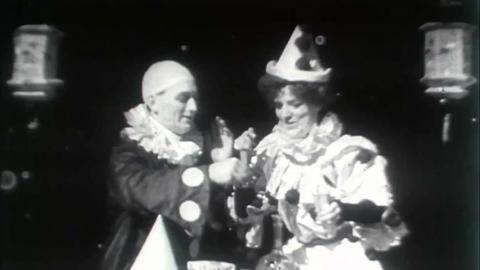This film is part of Free

Two Clowns
A showcase for GA Smith’s patented Kinemacolor process, based around a suitably colourful subject
Overview
Experiments with colour film date back to the dawn of cinema itself, but one of the more technically successful early examples was Kinemacolor, patented in 1909 by George Albert Smith (1864-1959) after years of tests. Visually, this film is similar to the comic 'facials' that Smith helped pioneer in the late Victorian era, but the decision to use clowns (one played by his wife Laura Bayley) gave him the opportunity to display and control the colours that registered best with the system: red and green.
A former stage mesmerist, Smith knew that he could fool the viewer into perceiving colours that weren’t there, so by shooting alternate frames through red and green filters and projecting them the same way, he achieved a remarkably effective simulation, at least to viewers who had yet to experience Technicolor and its successors. Smith’s biggest technical challenge was to create a film stock that would be sufficiently sensitive to the whole colour spectrum. Existing orthochromatic film was fine for black and white, but proved unsuitable for anything else, especially where reds were involved.
Related

The Perfect Woman The Perfect Woman
Comedy 1949 87 mins
In a bid to improve on nature, a scientist creates a robot female. But the experiment doesn't quite turn out as planned...

Tilly and the Fire Engines Tilly and the Fire Engines
Comedy 1911 2 mins Silent
Mischievous sisters Tilly and Sally borrow a fire engine and take it for a joy ride in this spirited film comedy.

Something Completely Different Something Completely Different
1974 4 mins Silent Location: Doune
Join John Cleese and the cast of Monty Python and the Holy Grail on location in Scotland

Miranda Miranda
Comedy 1948 80 mins
A man goes fishing and comes home with a most unusual catch in this comedy feature.

Le Petomane Le Petomane
Comedy 1979 33 mins
The immortal Leonard Rossiter makes flatulence a fine art in this short, poignant comedy-drama from Hancock writers Galton and Simpson

Arthur? Arthur! Arthur? Arthur!
Comedy 1969 101 mins Location: Camden
A hen-pecked inventor plots murder while he leads a bizarre double life as a bewigged playboy who runs a dating agency

China O'Brien: The Reunion China O'Brien: The Reunion
Documentary 2024 60 mins
Cynthia Rothrock, Richard Norton and Keith Cooke reunite three decades on from the groundbreaking martial arts classic.

Women in Action Panel Discussion Women in Action Panel Discussion
Inside Film 2024 28 mins
Action Xtreme - the UK's leading action film studio - hosts this panel discussion with four leading women in action cinema - Soo Cole, Jo Rolison, Jadey Duffield and Ioanna Karavela.

Starve Acre - Exclusive Q&A Starve Acre - Exclusive Q&A
Short interview 2024 24 mins
Daniel Kokotajlo talks to Nia Childs about Starve Acre, his folk horror about a couple digging deep into grief in the heart of the Yorkshire Dales.

Sky Peals - Exclusive Q&A Sky Peals - Exclusive Q&A
Short interview 2024 30 mins
Sky Peals director Moin Hussain and lead actor Faraz Ayub talk to Tomisin Adepeju about their magic realist drama.

Inside the Archive: The Early Films of Michael Powell Inside the Archive: The Early Films of Michael Powell
Documentary 2024 42 mins
Documentary exploring the BFI National Archive’s role in rediscovering and remastering the early films of Michael Powell.

Inside the Archive: The Riviera Revels Inside the Archive: The Riviera Revels
Short documentary 2024 12 mins
Bryony Dixon, curator of silent film at the BFI national archive, explores the origins of a series of comic travelogues, and Michael Powell's involvement in making them.